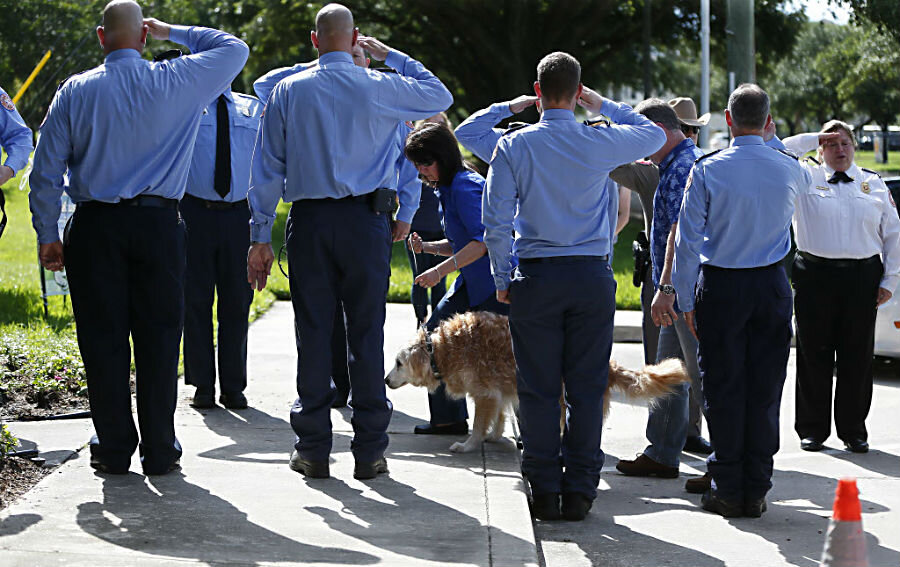America says goodbye to Bretagne, the last 9/11 search and rescue dog
Loading...
The last surviving 9/11 rescue dog was put down on Monday. With her body wrapped in an American flag, she was given a proper farewell as firefighters and rescue workers lined a Texas sidewalk to say goodbye.
Bretagne (pronounced Brittany) was a 16-year-old golden retriever. Her owner, Denise Corliss, walked her down a path of firefighters at the Cy-Fair Fire Department in Harris County, Texas, toward the Fairfield Animal Hospital to be euthanized.
"She served our country by deploying to the World Trade Center 9/11 disaster, she deployed to Hurricane Katrina, Hurricane Rita, several other deployments," Captain David Padovan of the Cy-Fair volunteer fire department, told CNN. Later, Bretagne retired to Texas and joined first graders once a week during reading class.
In recent years, Bretagne had experienced kidney failure, and began slowing down. Her joints were so stiff and caused so much pain that she could no longer climb the stairs at home. Then when she stopped eating for three days, Corliss took it as a sign it was time to put her down. "She was really anxious last night and she just wanted to be with me," Corliss told NBC News. "So I laid down with her, right next to her. When she could feel me, she could settle down and go to sleep. I slept with her like that all night." Bretagne would have turned 17 on August 25.
In 2001, Bretagne and Ms. Corliss had graduated Disaster City, a 52-acre search and rescue training center in College Station, Texas. Soon after they were deployed to New York to help with the search and recovery efforts at the former World Trade Center site in the immediate aftermath of the 9/11 terrorist attacks. Corliss and Bretagne worked nearly 12 hours each day for two weeks, looking for survivors in the wreckage. Unfortunately, there were none left for Bretagne to find.
Still, Bretagne was a special asset to the search and rescue team. Corliss remembers how firefighters and rescuers would pet Bretagne and share their stories with Corliss to describe the missing loved ones the team was searching for. "Dogs can be so comforting, so it makes sense to me now," said Corliss, describing Bretagne as a type of therapy dog. "I just didn't anticipate that, then."
Not only was Bretagne a comfort to others and a hard worker, but she was also selfless and brave. Once Bretagne walked to the edge of a dangling staircase during a search. "She walked to the edge of it and she stopped – turned – and she came back down," Corliss told CNN in 2014. "She did exactly what she was supposed to do, but it scared me a bit." Even with all Bretagne's training, Corliss at times worried about Bretagne.
Since puppyhood, however, Bretagne proved to be the kind of dog who would succeed in stressful, chaotic conditions of disaster aftermath. Puppies who may do this kind of work need to go through a strict screening process.
Corliss recalls that Bretagne was "pushy." When the two first met, Bretagne charged through a pack of eight other puppies from the back of a plastic kennel to greet Corliss. "That kind of pushy behavior helped her be the persistent don't-give-up-style of working dog that I needed later," said Corliss.
In 2009, Bretagne left the Texas Task Force 1 to work for a local fire department as a search and rescue dog. A few years later, she retired and began volunteer work in elementary schools. She helped shyer children get over their fears about reading aloud to other people, said Corliss. These children instead had an opportunity to read to Bretagne, who offered a "non-judgmental ear and a soft paw," according to the Cy-Fair Volunteer Fire Department. Bretagne also visited students with special needs, including autism.
"Her calm demeanor and warm heart helped the young and old through their own difficult moments," said the Cy-Fair fire department, reported the Dallas Morning News.







